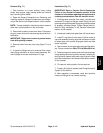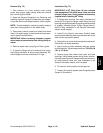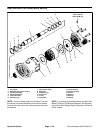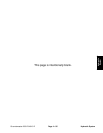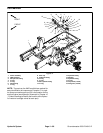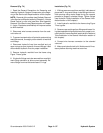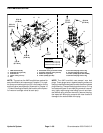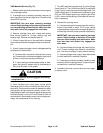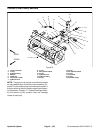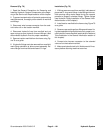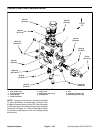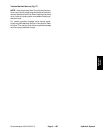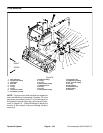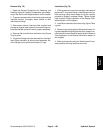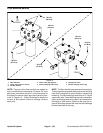
Groundsmaster 4000--D/4010--D Hydraulic SystemPage 4 -- 99
4WD Manifold Service (Fig. 75)
1. Make sure the manifold is clean before removingany
of the cartridge valves.
2. If cartridge valve is solenoid operated, remove nut
securing solenoid to the cartridge valve. Carefully slide
solenoid off the valve.
IMPORTANT: Use care when removing cartridge
valves. Slight bending or distortion of the stem tube
can cause binding and malfunction. Make sure that
deep well socket fully engages the valve base.
3. Remove cartridge valve with a deep well socket.
Note correct location for O--rings, sealing rings and
backup rings. Remove and discard seal kit.
4. Visually inspect the port in the manifold for damage
to the sealing surfaces,damaged threadsor contamina-
tion.
5. Visually inspect cartridge valve for damaged sealing
surfaces and contamination.
A. Contamination may cause valves to s tick or hang
up.Contaminationc an become lodged in smallvalve
orifices or seal areas causing malfunction.
B. If valve sealing surfaces appear pitted or dam-
aged, the hydraulic system may be overheating or
there may be water in the system.
CAUTION
Use eye protection such as goggles when using
compressed air.
6. Clean cartridge valve using clean mineral spirits.
Submerge valve in clean mineral spirits to flush out con-
tamination.Particles as fine as talcumpowder canaffect
the operation of high pressure hydraulic valves. If car-
tridge design allows, use a wood or plasticprobe to push
the internal spool in and out 20 to 30 times to flush out
contamination. Be extremely careful not to damage car-
tridge. Use compressed air for cleaning.
7. The 4WD manifold includes three (3) orifice fittings
(items 9 and 12). The 0.030 orifice (item 9) is positioned
in the SV port under the solenoid cartridge valve. The
0.050 orifices (item 12) thread into the manifold in ports
OR1 and OR2. Before removing or installing the orifice
in OR1, removal of the #6 plug in the bottom of the man-
ifold is necessary.
8. Reinstall the cartridge valve:
A. Lubricate new seal kit components with clean hy-
draulic oil and install on valve. The O--rings, sealing
rings and backup rings must be arranged properly on
the cartridge valve for proper operation and sealing.
IMPORTANT: Use care when installing cartridge
valves. Slight bending or distortion of the stem
tube can cause binding and malfunction. Make
sure that deep well socket fully engages the
valve base.
B. Lubricate threads of cartridge with clean hydrau-
lic oil. Thread cartridge valve carefully into manifold
port. The valve should go in easily without binding.
C. Torque cartridge valve using a deep well socket
to value identified in manifold illustration.
D. If cartridge is solenoid operated, carefully install
solenoid coil to the cartridge valve. Torque nut to val-
ue identified in manifold illustration.
9. If problems still exist, remove valve and clean again
or replace valve.
Hydraulic
System



